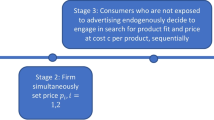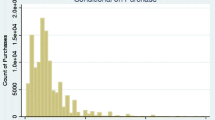Abstract
In this paper we explore the relations among advertising spending, capacity and quality for services. Data from a sample of New York City restaurants show that mid-quality restaurants spend more on advertising than either high quality or low quality ones, contradicting the usual Nelson-type prediction that advertising spending increases with quality. Also, controlling for quality, restaurants with larger capacities advertise more. We present a model of services to explain these observations. The key features of the model are: (1) capacity constraints, (2) uncertain demand, (3) the presence of both informed and uninformed consumers, and (4) a technological link between capacity and quality. We argue that for services, advertising not only informs consumers, but it also can improve capacity utilization. Given this dual role, advertising is more valuable to firms with larger capacities and higher price-cost margins. The variation of these two elements with quality determines the advertising-quality relation.
Similar content being viewed by others
References
Archibald, R.B., C.H. Haulman, and C.E. Moody, Jr. (1983). “Quality, Price, Advertising and Published Quality Ratings”, Journal of Consumer Research 9, 347-356.
Batra, R. and M.L. Ray. (1986). “Affective Responses Mediating Acceptance of Advertising”, Journal of Consumer Research 13 (September), 234-249.
Biyalogorsky, E., Z. Carmon, G.E. Fruchter, and E. Gerstner. (1999). “Overselling with Opportunistic Cancellations”, Marketing Science 18, 605-610.
Butters, G.R. (1977). “Equilibrium Distributions of Sales and Advertising Prices”, The Review of Economic Studies XLIV, 465-491.
Cacioppo, J.T. and R.E. Petty. (1985). “Central and Peripheral Routes to Persuasion: The Role of Message Repetition”. In L.F. Alwitt and A.A. Mitchell (eds.), Psychological Processes and Advertising Effects. Hillsdale, N.J.: Lawrence Erlbaum Associates.
Caves, R.E. and D.P. Greene. (1996). “Brands' Quality Levels, Prices, and Advertising Outlays: Empirical Evidence on Signals and Information Costs”, International Journal of Industrial Organization 14, 29-52.
Collins, G. (1996). “A Big Mac Strategy at Porterhouse Prices”, The New York Times, August 13.
Essegaier, S., S. Gupta, and Z. John Zhang. (2002). “Pricing Access Services”, Marketing Science 21, 139-159.
Fudenberg, D. and J. Tirole. (1991). Game Theory. Cambridge, MA: MIT Press.
Grossman, G.M. and C. Shapiro. (1984). “Informative Advertising with Differentiated Products”, The Review of Economic Studies 51 (January), 63-81.
Hertzendorf, M.H. (1993). “I'm not a High-Quality Firm-But I Play One on TV”, The Rand Journal of Economics 24, 236-247.
Horstmann, I. and G. MacDonald. (1994). “When is Advertising a Signal of Product Quality?”, Journal of Economics and Management Strategy 3, 561-584.
Kihlstrom, R.E. and M.H. Riordan. (1984). “Advertising as a Signal”, Journal of Political Economy 92, 427-450.
Kirmani, A. (1990). “The Effect of Perceived Advertising Costs on Brand Perceptions”, Journal of Consumer Research 17, 160-171.
Klein, B. and K.B. Leffler. (1981). “The Role of Market Forces in Assuring Contractual Performance”, Journal of Political Economy 89, 615-641.
Kotowitz, Y. and F. Mathewson. (1979). “Informative Advertising and Welfare”, The American Economic Review 69 (June), 284-294.
Kwoka, J.E. (1984). “Advertising and the Price and Quality of Optometric Services”, American Economic Review 74, 211-216.
Levitt, T. (1986). The Marketing Imagination. New York: The Free Press.
Levy, D., M. Bergen, S. Dutta, and R. Venable. (1997). “The Magnitude of Menu Costs: Direct Evidence from Large U.S. Supermarket Chains”, Quarterly Journal of Economics 12, 791-825.
MacKinnon, J.G. and N.D. Olewiler. (1980). “Disequilibrium Estimation of the Demand for Copper”, Bell Journal of Economics 11, 197-211.
Mahajan, V. and E. Muller. (1986). “Advertising Pulsing Policies for Generating Awareness for New Products”, Marketing Science 5, 86-106.
Mayzlin, D. (2002). “Promotional Chat on the Internet”, Working Paper, Yale University.
Milgrom, P. and J. Roberts. (1986). “Price and Advertising Signals of Product Quality”, Journal of Political Economy 94, 796-821.
Montgomery, C.A. and B. Wernerfelt. (1992). “Risk Reduction and Umbrella Branding”, The Journal of Business 65 (January), 31-50.
Nelson, P. (1974). “Advertising as Information”, Journal of Political Economy 81, 729-754.
Ordonez, J. (2000). “An Efficiency Drive: Fast-Food Lanes, Equipped with Timers, Get Even Faster”, The Wall Street Journal, May 18.
Parker, P.M. (1995). “‘Sweet Lemons’: Illusory Quality, Self-Deceivers, Advertising, and Price”, Journal of Marketing Research XXXII, 291-307.
Png, I.P.L. (1989). “Reservations: Customer Insurance in the Marketing of Capacity”, Marketing Science 8, 248-264.
Rizzo, J.A. and R.J. Zeckhauser. (1990). “Advertising and Entry: The Case of Physician Services”, Journal of Political Economy 98, 476-500.
Schmalensee, R. (1978). “A Model of Advertising and Product Quality”, Journal of Political Economy 86, 485-503.
Shapiro, C. (1983). “Premiums for High Quality Products as Returns to Reputations”, The Quarterly Journal of Economics 98 (November), 659-680.
Stewart, D.W. and D.H. Furse. (1986). Effective Television Advertising. Lexington, Massachusetts: Lexington Books.
Smith, R.J. and R.W. Blundell. (1986). “An Exogeneity Test For a Simultaneous Equation Tobit Model with an Application to Labor Supply”, Econometrica 54, 679-685.
Villas-Boas, M. (1993). “Predicting Advertising Pulsing Policies in an Oligopoly: A Model and Empirical Test”, Marketing Science 12, 88-102.
Xie, J. and S.M. Shugan. (2001). “Electronic Tickets, Smart Cards, and Online Prepayments: When and How to Advance Sell”, Marketing Science 20, 219-243.
Author information
Authors and Affiliations
Rights and permissions
About this article
Cite this article
Horstmann, I.J., Moorthy, S. Advertising Spending and Quality for Services: The Role of Capacity. Quantitative Marketing and Economics 1, 337–365 (2003). https://doi.org/10.1023/B:QMEC.0000003333.38298.ed
Issue Date:
DOI: https://doi.org/10.1023/B:QMEC.0000003333.38298.ed




